Finite Element Analysis has long helped design traditional power plants. Now, it’s proving a boon for designing “green” facilities, like wind turbines and wave power.
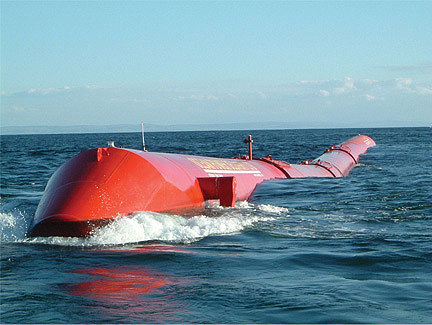
Pelamis Wave Energy Converter during sea trials.
Power generating equipment must be designed for both immediate cost-efficiency and a long lifespan. Realistic simulation with (FEA) is a critical tool that solves a range of engineering challenges.
What’s the ideal configuration of a turbine blade? Which new alloys will work best in a gas/steam combined cycle plant? How can spent nuclear fuel be stored in a safe and secure manner? How can you adapt a land-based wind turbine design to a deep-water installation? Can electricity be generated from wave power cost-effectively? FEA can help guide the design process and provide answers to such questions.
To find answers, start with a CAD model — perhaps of an airfoil, a nuclear plant piping component, or the blade of a wind turbine — and then use FEA software to transform that model into a 3D mesh of geometric units. Linked together by nodes that quantify their interrelationship, the elements (which can number in the hundreds of thousands or even millions) are further constrained by boundary conditions, material characteristics, and other inputs dictated by type of product or structure modeled.
Once an FEA model is set up, any number of static, dynamic, linear or nonlinear events, including contact, collisions, buckling and collapse scenarios, and even multiphysics analyses (thermal-structural, fluid structure interaction and computational fluid dynamics), can be analyzed. Feedback from the FEA analysis (‘virtual testing’) is then used to evaluate and modify the CAD design, repeatedly if necessary, until the desired function and durability are reached.
Wind Power: The wind power industry is experiencing something of a boom lately as government and private sector support grows. Taller structures are being designed to take advantage of stronger wind speeds at higher elevations and also to offset greater installation costs in the case of offshore wind farms.
Design and simulation of wind turbine towers and foundations is second nature for FEA software vendors with experience in the oil and gas offshore industry. All of the necessary material models are available for simulating foundations, such as concrete, the behavior of soils, and soil/structural interactions. Linear dynamics capture vibration (earthquake) effects, while static and dynamic nonlinear analyses simulate complex fluid-structure interactions or failure mechanisms.
Rotor blades are possibly the most visible and critical part of a wind turbine. Composites are a leading blade material; FEA modeling techniques for composites, initially driven by aerospace, are highly applicable when exploring such new materials for strength and durability in challenging weather. The software supports composite preprocessing steps such as definition of layups, distribution of orientations and thickness, and visualization of various plies. For modeling purposes, a wide range of element types (solid shells, continuum shells, and so forth) can be used together with different material and failure models, such as the Virtual Crack Closure Technique (VCCT), which was developed by Boeing and refined by Simulia.
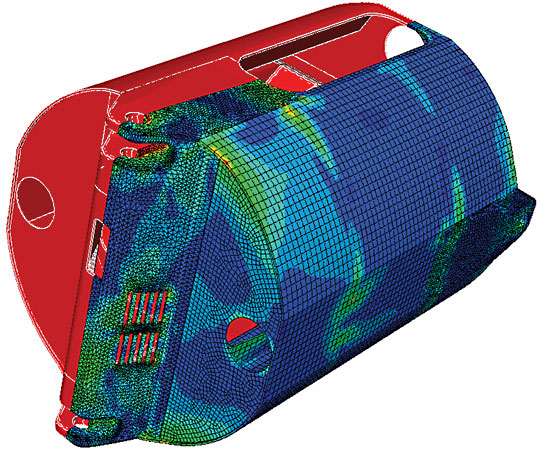
Abaqus finite element analysis is used by Pelamis Wave Power engineers to evaluate the structural integrity and nonlinear behavior of their power generating machines.
Another critical part of a wind turbine is the bearings; several bearings manufacturers use FEA to model and simulate the contact behavior of bearing parts. The software solution takes advantage of built-in stabilization features and advanced contact algorithms. Process automation and optimization tools can be applied to FEA analysis of bearings and other aspects of wind power development to identify optimum design parameters for the most efficient and cost-effective design.
Other Green-Power sources: One novel application in which FEA has been used recently is Pelamis Wave Power’s wave energy converter, which floats on the ocean surface and generates electricity from waves. Hydraulic rams resist the motion of the waves and pump hydraulic fluid through electricity-producing generators; a wave farm of multiple units can provide electric power for thousands of homes. Pelamis is studying fatigue and durability in their product using FEA applications to analyze the performance of both small components and larger assemblies to simulate and make appropriate modifications.
Other alternative energy sources, including solar power and fuel cells, are becoming viable on a scale that increasingly makes economic as well as environmental sense. The cost-effective development of both traditional and newer energy sources requires state-of-the art simulations, such as nonlinear FEA, design optimization, and simulation lifecycle management. These technology tools evaluate real-world behavior of a diverse array of power generating equipment and lead to rapid and accurate performance-based design decisions.
Traditional Power – turbomachinery: All turbomachines work on essentially the same set of physics and all can benefit from FEA simulation. One common FEA application is turbine blade design, particularly of the last stage blades that are long and thin and carry a huge mechanical load. The strength of materials from which the blades are manufactured is critical: the high temperatures and low pressures at which a gas turbine functions–or, by contrast, the lower temperatures and widely fluctuating pressures along a single steam turbine rotor– will affect the behavior of parts and materials in different ways all along the 30 or 40 stages in a power plant. Extensive FEA materials libraries allow modeling to predict the response of different materials–whether titanium, advanced alloys, ceramics or composites–under such huge temperature and pressure differentials.
Blade tuning to avoid flutter is another design issue where FEA, often in combination with computational fluid dynamics (CFD), can be extremely powerful. The analysis of the interaction between vortex shedding from the blade and its mechanical vibration is a very nonlinear, transient engineering problem: if the vortex shedding excites a mode in the blade it can shatter catastrophically. Modal analysis with FEA can spot the problem in advance.
Other important FEA applications in turbomachinery include examining the attachment of blades to the disk and predicting the performance of the casings that contain the blading. Competing tradeoffs between weight, performance and size must be balanced, and FEA can help avoid over-design as well as under-design. The comprehensive procedure library in an FEA code enables the engineer to evaluate dynamics, cyclic symmetry, creep, contact, natural frequency extraction of a spinning engine and more.
Nuclear Power: FEA has been employed by the nuclear industry for decades because it provides sophisticated calculation techniques compatible with the demanding quality standards required for nuclear power-plant construction. Simulia in particular has developed many of its cross-industry Abaqus capabilities from work originating in this field.
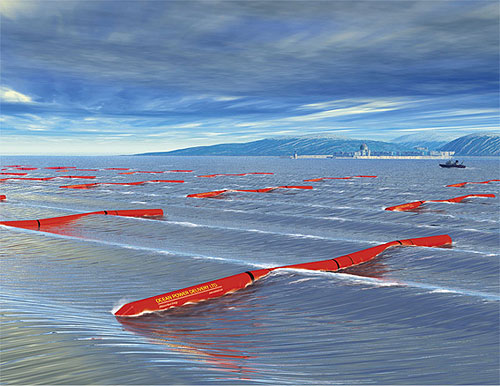
A 30 Megawatt ‘wave farm’ of Pelamis Wave Energy Converters will occupy a square kilometer of ocean surface and produce electricity for 20,000 homes. Courtesy of Pelamis Wave Power.
For nuclear plant equipment, like reactors, piping and concrete protection barriers, FEA provides a variety of tools:
• Material models for plasticity, creep, and the behavior of concrete.
• Fracture and failure analysis techniques.
• Special pipe (elbow) elements for simulating all operating aspects of the plant. For example, piping in nuclear plants can be simulated (pipe elbows are a specific type of finite element) and evaluated for heat transfer, thermal stress and pipe-whip.
In the all-critical arena of nuclear fuel storage, nonlinear FEA can be used for drop testing of spent fuel storage vessels, to perform thermal-stress analysis of the storage mechanism, or to evaluate the effects of fire on a storage vessel for radioactive waste material. Other applications include thermo-hydro mechanical safety evaluations of underground storage, taking into account soil saturation and compaction over long periods of time. This latter example employs similar capabilities–such as soil models and coupled pore fluid diffusion and stress analysis–as those used in geomechanics and the oil & gas industry.
The nuclear industry is facing two major challenges going forward: the development and installation of next-generation nuclear reactor technologies, which will certainly benefit from extensive analysis with FEA, and service assessments of existing older plants for which FEA can be used either for recertification or for safe decommissioning.
Dassault Systèmes SIMULIA
www.simulia.com
Filed Under: Software • FEA, Green engineering • renewable energy • sustainability, Software • simulation, ENGINEERING SOFTWARE



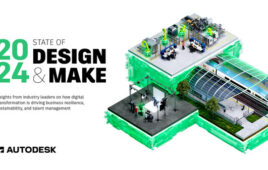
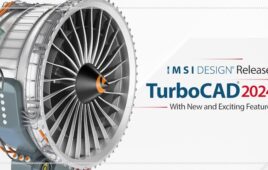
Tell Us What You Think!